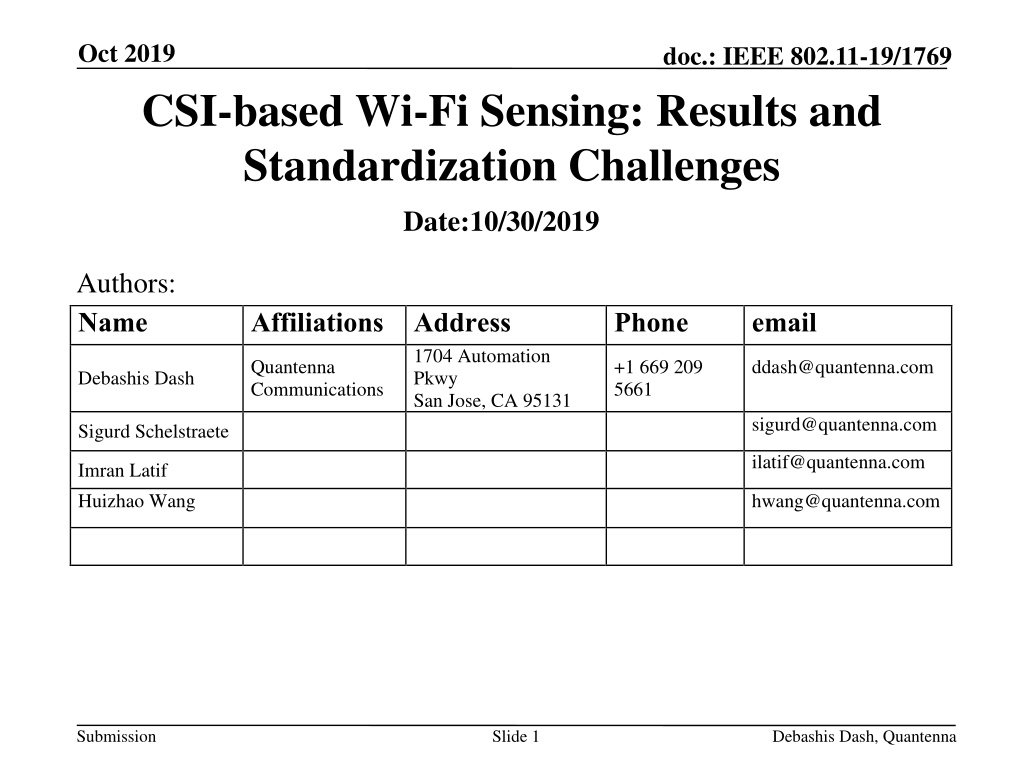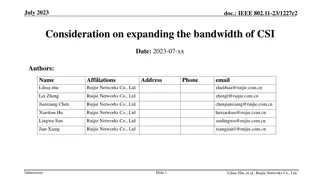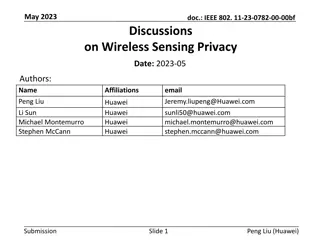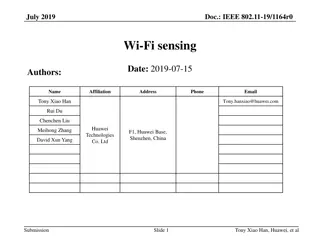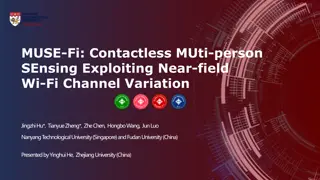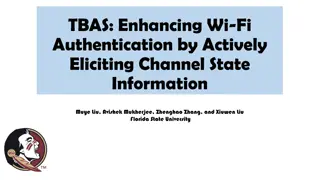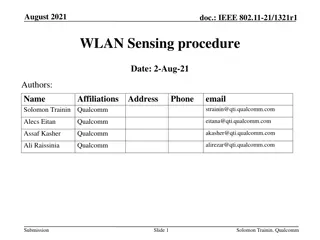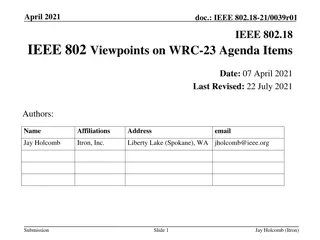IEEE 802.11-19/1769: CSI-based Wi-Fi Sensing Results & Challenges
This document from Oct. 2019 explores IEEE 802.11-19/1769 CSI-based Wi-Fi sensing, focusing on results and standardization challenges. It delves into the concept of Wi-Fi sensing, its applications in security, automation, healthcare, and more, as well as the importance of CSI parameters such as resolution, periodicity, and coverage. The discussions highlight the need for reliability, consistency, and interoperability in utilizing CSI for various sensing applications.
Download Presentation

Please find below an Image/Link to download the presentation.
The content on the website is provided AS IS for your information and personal use only. It may not be sold, licensed, or shared on other websites without obtaining consent from the author. Download presentation by click this link. If you encounter any issues during the download, it is possible that the publisher has removed the file from their server.
E N D
Presentation Transcript
Oct 2019 doc.: IEEE 802.11-19/1769 CSI-based Wi-Fi Sensing: Results and Standardization Challenges Date:10/30/2019 Authors: Name Affiliations Address Phone email 1704 Automation Pkwy San Jose, CA 95131 Quantenna Communications +1 669 209 5661 ddash@quantenna.com Debashis Dash sigurd@quantenna.com Sigurd Schelstraete ilatif@quantenna.com Imran Latif Huizhao Wang hwang@quantenna.com Submission Slide 1 Debashis Dash, Quantenna
Oct 2019 doc.: IEEE 802.11-19/1769 Wi-Fi Sensing What is Wi-Fi Sensing? [1, 2] Using existing standardized 802.11-based protocols to sense and track changes in the environment Status Interest in WNG July session TIG created in September session to further explore Wi- Fi sensing Why Wi-Fi? Ubiquitous, re-use existing technology for new use cases Device-free, extra sensor-free, privacy-friendly Feasible for interesting sensing applications [3, 4, 6, etc.] What is missing? Reliability, consistency and availability of CSI Interoperability Submission Slide 2 Debashis Dash, Quantenna
Oct 2019 doc.: IEEE 802.11-19/1769 Use Cases* Security Home security intrusion detection Device security personal electronics, vehicle unlocking Automation Smart home automation, HVAC control Gesture recognition smart device control, gaming Health care Elderly care Fall detection Recuperation Gait and presence detection Localization Indoor and reverse location *Also discussed in [3-6] Submission Slide 3 Debashis Dash, Quantenna
Oct 2019 doc.: IEEE 802.11-19/1769 Standard Compliant CSI Extraction STA2 STA1 NDPA Explicit CSI tracking based on CBF Limited resolution due to compression NDP CSI (1->2) CBF STA2 STA1 Implicit CSI tracking based on LTF Overhead without existing traffic CSI (2->1) Data Channel direction not crucial Typical use cases only track changes over time Submission Slide 4 Debashis Dash, Quantenna
Oct 2019 doc.: IEEE 802.11-19/1769 CSI Parameters of Significance Resolution Many application require high resolution (without compression) CSI Periodicity Some use cases like fall detection might need a reliable periodicity of CSI Coverage Depending on the size of the monitoring location coverage is essential Beamforming might affect isotropic coverage Overhead In order to keep airtime usage low more efficient protocol needed Slide 5 Submission Debashis Dash, Quantenna
Oct 2019 doc.: IEEE 802.11-19/1769 Standardization Challenges* (1) CSI from Stationary Environment TX-side Adaptations Examples BW adaptation TX Power adaptation Beamforming, Antenna selection Power-save mode Possible solution Standardize indicator Fix parameters for sensing Parameter Set 1 Parameter Set 2 * Challenges that can be alleviated by standardization Submission Slide 6 Debashis Dash, Quantenna
Oct 2019 doc.: IEEE 802.11-19/1769 Standardization Challenges (2) Sounding Overhead [7, 8] Examples Explicit sounding periodicity control of sounding frames Implicit sounding data overhead Possible solution Efficient, scheduled sounding Interoperability Availability and feature parity of CSI in current HW Airtime comparison for implicit sounding [7] STA2 STA1 Echo Request Ack Echo Response Ack Example implicit sounding in absence of background traffic Submission Slide 7 Debashis Dash, Quantenna
Oct 2019 doc.: IEEE 802.11-19/1769 Standardization Challenges (3) Privacy Examples Passive sensing overhearing active links Active sensing new link based tracking Possible solution Standardized obfuscation or encryption Problem backward compatibility Submission Slide 8 Debashis Dash, Quantenna
Oct 2019 doc.: IEEE 802.11-19/1769 Conclusions Wi-Fi sensing is growing in demand with many implemented solutions indicating feasibility Standard-compliant CSI is an existing feature that can enable numerous practical applications Standardization can make the CSI extraction process private, efficient and improve interoperability Submission Slide 9 Debashis Dash, Quantenna
Oct 2019 doc.: IEEE 802.11-19/1769 References [1] Wi-Fi sensing, IEEE 802.11-19/1164 [2] Wi-Fi sensing: cooperation and standard support, IEEE 802.11-19/1416 [3] Wi-Fi sensing: Usages, requirements, technical feasibility and standards gaps, IEEE 802.11-19/1293 [4] 802.11 sensing: Applications, feasibility, standardization, IEEE 802.11-19/1626 [5] Usage models for WLAN sensing, IEEE 802.11-19/1725 [6] Discussion of market potential and technical feasibility about WLAN sensing, IEEE 802.11-19/1726 [7] MU sounding improvements, IEEE 802.11-18/1191 [8] Sounding-only support during ranging, IEEE 802.11-18/1630 Submission Slide 10 Debashis Dash, Quantenna
